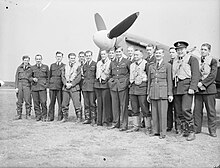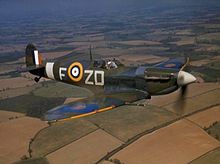Paddy Finucane
Thomas' father, Brendan Finucane's grandfather, was an Irishman who had served in the King's Own Scottish Borderers on the North-West Frontier Province.
[14][15][16] After a visit to England in July 1936 Thomas Finucane, now a company director, decided to establish an office in the West End of London.
Despite his Republican past, the senior Finucane agreed, believing a military career would provide a sense of direction lacking in his own youth.
After waiting two months, in August 1938 Brendan Finucane was ordered to report to the 6 Elementary and Reserve Flying Training School at Sywell in Northamptonshire.
After completing basic flight training on 28 October 1938, Finucane was classed as an average pilot, but deemed to be competent enough to be assigned to advanced flying school.
With effect from the following day, he was granted a short-service commission as an acting pilot officer (on probation) and sent to 8 Flying Training School, RAF Montrose in Scotland.
On 12 November, he left King's Cross railway station travelling on the Flying Scotsman to Glasgow, arriving at Montrose after a 10-hour journey.
Anxious to get more experience, Finucane loitered around dispersal hoping to build up flight time on the Spitfire by asking as many senior officers for as many hours practice as was possible.
It developed a glycol leak whilst climbing and the cockpit filled with escaping vapour from the cooling liquid condensing on the hot engine.
Scrambling at 16:00 to intercept an incoming raid near Dover, 65 Squadron encountered large numbers of Bf 109s from Jagdgeschwader 51 led by Hannes Trautloft.
A squadron report on 9 September noted that Finucane was learning quickly and showing signs of becoming an efficient combat leader; "I have great hopes of this officer.
The Ju 88 flew low-level skidding turns and into the sun where the glare prevented the British pilots from gaining a clear view.
Galland had taken off with his wingman and a crate containing lobster loaded into the fuselage of his Bf 109 to deliver to Jagdfliegerführer 2 Theo Osterkamp for his birthday at Luftflotte 2 headquarters.
En route, Galland took a detour over the English coast and attacked several flights of Spitfires, claiming two 266 squadrons shot down.
The day was best remembered in Fighter Command for the loss of Flight Lieutenant Eric Lock who was shot down by ground-fire in the morning patrol.
Over Saint Omer at 11:32 Finucane engaged eight Bf 109s and with a long four-second burst of machine gun and cannon-fire from 100 yards one of the Messerschmitts caught fire and went into a spin.
[50] Over the next few days 452 re-equipped with Spitfire VBs which had two Hispano-Suiza HS.404 calibre cannon in each wing to supplement four 7.7 mm (0.303 in) Browning machine guns.
[54] The success of 452 and its highest scoring pilot Brendan Finucane brought fame and publicity and information about the squadron's exploits was released by the Air Ministry to the press.
The Daily Mail, a believer in publishing fighter pilots' exploits since World War I, ran the headline "Spitfire Finucane shoots down 20 Nazis" [sic].
Walking back to their quarters Finucane jumped Croydon Town hall's stone balustrade parapet which hid an 18-foot drop the other side which broke his heel bone and put him in hospital for several weeks.
He gave evidence before the Fuller Enquiry which reported on the failure to prevent the break-out before Air Chief Marshal Edgar Ludlow-Hewitt and Vice Admiral Hugh Binney.
Finucane returned to operations on 13 March; 602 had been strengthened by the arrival of Flight Lieutenant James Harry Lacey, an established fighter pilot and ace with considerable combat experience.
Air Chief Marshal Charles Portal requested proof from Sholto Douglas to demonstrate Fighter Command's claims were accurate.
Douglas issued him with combat reports from the Kenley Wing which stated two German aircraft were seen to hit the ground and one pilot bailed out.
[72] Duncan Smith later said, that though he admired Finucane, he resented the young fighter pilot's appointment and felt as an older, experienced leader, he could have led the wing himself.
[74] On 15 July, Finucane was killed at the age of 21 while leading the Hornchurch Wing in a fighter "Ramrod"—ground attack—operation targeting a German Army camp at Étaples, France.
If Finucane had released them it is possible he could have been thrown forward onto the gun-sight and killed, or knocked unconscious and drowned; the circumstances remain unknown.
A rose was planted in the memorial garden in Baldonnel Aerodrome in Dublin (home of the Irish Air Corps) where Brendan and his brother Ray first flew.
[79] An oil portrait, "Wing Commander Brendan Finucane (1920–1942), DSO, DFC" by John Thomas Young Gilroy (1898–1985), hangs in the Battle of Britain Hall, Royal Air Force Museum, Hendon.
Historian Donald Caldwell has attempted to use what limited German material is available to compare losses and air victory claims but acknowledges the lack of sources leave the possibility for error.






